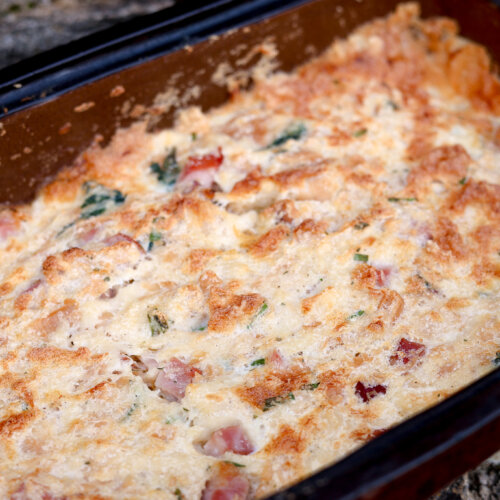
Traditional Czech Easter Stuffing "Velikonoční Nádivka"
Czech Easter Stuffing is a traditional Czech Easter Food that is easy to make, tastes delicious and makes a perfect side to lamb or other meats.
Equipment
- KitchenAid KHB2351CU 3-Speed Hand Blender - Contour Silver, 8 inches
Ingredients
- 7 slightly stale bread rolls or white bread
- 2 tbs melted butter 30g
- 3/4 cups milk 200ml
- 2 bunches fresh nettles
- 6 fresh eggs
- 1 bunch fresh parsley
- 1 bunch fresh chives
- 1/2 tsp baking powder
- 1/2 tsp salt
- nutmeg & pepper to taste
- optional: bacon bits or other smoked meat any other spring herbs
Instructions
- Preheat oven to 300F (200C)
- Chop your bread rolls into cubes. Separate eggs whites from egg yolks in two separate bowls.
- Place chopped bread rolls into a large bowl and cover with milk. Let sit for a few minutes, until the bread absorbs most of the milk. Squeeze out any excess milk and drain.
- Whisk egg yolks until smooth and mix in with the bread equally.
- Add bacon bits (if using), melted butter, chopped nettles, chopped chives and parsley. Mix well.
- Then add in the baking powder, salt, pepper and nutmeg to taste.
- Whip egg whites until you get stiff peaks. Gently stir into your mixture, being careful not to overmix.
- Grease the inside of a baking dish with butter. Pour the mixture inside the baking dish
- Bake for roughly 30minutes, until the top is golden brown.
- Serve sprinkled with fresh green herbs.
Notes
- Use Stale Bread: Stale bread works best for Czech Easter stuffing as it absorbs the liquid ingredients better. Cube or tear the bread into small pieces and let it dry out for a day or two before using it in the recipe.
- Toast the Bread: If you're short on time and don't have stale bread, you can toast the bread cubes in the oven until they're lightly golden brown. This helps to remove excess moisture and adds a nice crunch to the stuffing.
- Season Well: Don't skimp on the herbs and seasonings. Traditional Czech Easter stuffing is flavored with herbs like marjoram, parsley, salt, and pepper. Adjust the seasonings to taste, and consider adding other herbs or spices for extra flavor.
- Add Texture: For added texture and flavor, consider incorporating ingredients like chopped mushrooms, bacon bits, or dried fruits and nuts into the stuffing mixture. These additions can elevate the dish and add complexity.
- Experiment with Greens: If you can't find nettles, you can substitute dandelion greens or other edible spring greens.
- Don't Overmix: When combining the soaked bread with the sautéed aromatics and other ingredients, be careful not to overmix the stuffing. Gently fold everything together until just combined to avoid a dense texture.
- Bake Until Golden Brown: Bake the stuffing in a preheated oven until it's golden brown on top and set in the middle. Keep an eye on it towards the end of the baking time to prevent it from burning.
- Let it Rest: Allow the Czech Easter stuffing to rest for a few minutes after removing it from the oven. This helps to set the texture and allows the flavors to meld together.
- Serve Warm: Czech Easter stuffing is best served warm alongside roasted meats like lamb or pork. Enjoy it as part of your Easter feast with family and friends!
Storage
- Cool Completely: Allow the stuffing to cool completely to room temperature before storing it. This helps prevent condensation inside the storage container, which can lead to sogginess.
- Refrigeration: If you plan to consume the stuffing within a few days, you can store it in an airtight container in the refrigerator. Make sure the container is tightly sealed to keep the stuffing fresh and prevent it from absorbing other odors in the fridge.
- Freezing: If you want to store the stuffing for longer-term use, you can freeze it. Place the cooled stuffing in a freezer-safe container or resealable freezer bags. Press out any excess air before sealing to prevent freezer burn.
- Portioning: Consider dividing the stuffing into smaller portions before refrigerating or freezing. This allows you to thaw only what you need without having to defrost the entire batch.
- Labeling: Don't forget to label the storage container or bags with the date of preparation. This helps you keep track of how long the stuffing has been stored and ensures you use it within a safe timeframe.
- Thawing: If you froze the stuffing, transfer it to the refrigerator to thaw overnight before reheating. This gradual thawing helps maintain the texture and flavor of the stuffing.
- Reheating: To reheat the refrigerated or thawed stuffing, you can warm it in the oven at a low temperature (around 300°F or 150°C) until heated through. Alternatively, you can microwave individual portions until they're hot.
- Check for Freshness: Before serving reheated stuffing, always check for signs of spoilage such as off odors or mold. If the stuffing doesn't smell or look right, discard it to avoid foodborne illness.